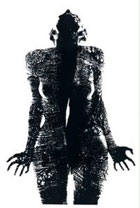
|
Sarah Kane more: acontrolleddetonation |

|
Sarah Kane more: acontrolleddetonation |
| A
Controlled Detonation:
Readers and especially directors have been challenged by the vague and disturbing staging information that accompanies much of the action in Kane’s plays. Some of it is quite surreal, for example in Cleansed the directions indicate that “A sunflower bursts through the floor and grows above their heads” [15] and that rodents perform in their own ancillary sub-drama, “There are two rats, one chewing at Grace/ Graham’s wounds, the other at Carl’s” [16] and that an array of rapes and mutilations occur, all diagrammed with gruesome specificity. While these instructions are painful to imagine, they are, at least recognizable within the text via italicization or parenthetical separation from the main dialogue. No similar advantage exists in 4:48 though it would be risky to say that none exist at all, at least not conventionally. In this mindscape of a play, stage instructions are embedded within the protean voice itself, giving the reader or director extra work to do but also imparting wide latitude for interpretation, as all great poetry should, here at the top of fragment two:
The strategy taken at the top of fragment two is highly innovative, abstracting performance information into a multi-level poetic cluster that anchors the fragment into a macabre setting appropriate to its function, which is to begin our journey into the heart of hell. This particular cluster is like a vision of doom, it suggests insects crawling over corpses under electric lights. And it helps frame the context of the next line, “I had a night in which everything was revealed to me/ How can I speak again?” which would sound like the start of an adventure tale - A Thousand and One Nights - were it not for the next vision of terror:
In a cinematic sense, fragment two is the establishing shot that reveals the alienating shape of things to come. By its surrealistic flourish, it sets in motion the experimental, protean voice of the play in the same manner that T.S. Eliot’s, “like a patient etherized upon a table” begins Prufrock’s spiritual fragmentation. [18] The voice of 4:48 employs similar subterranean imagery - “as I scuttled like a beetle along the backs of their chairs” echoing Eliot’s claws “scuttling along the floors of silent seas.” Kane’s words are meant for live theater and every piece of her text - the stage information, words, pauses, dashes, format changes, etc. - provides a substrate for interpretation. Fragment two also sets the tone of the play and like a chorus, points towards its major themes. In her doomed search for love, she may see herself as a “broken hermaphrodite”. The voices that beguile her may be the “they” that “were all there/ every last one of them” which includes us. And the command to remember and “believe the light” may be the clarity of truth that occurs at 4:48 am - the eye of the storm - which may also be the freeing light of death and perhaps the light of sanity that enables the play to be written and our minds to recall it. “Don’t let me forget” she says in the final line. Perhaps this is a clue to fragment one’s question of what we can offer our friends: we can offer a possibility of remembrance and understanding.
Fragment Three – The Problem Fragment two shifts time-space gears in the reader’s mind, fragment three starts the basic narrative engine. It is the true suicide note of the play. The first 25 lines are a litany of human disfigurement, carved by a wordsmith into a stone frieze of pain archetypal in its simplicity. Here the protean voice implodes within, self-consciousness turning on itself, mutating into a cancer that devours the spirit:
Copyright © 2007 Mustafa Sakarya reproduced on the site with the kind permission of the author |
click for next chapter
www.iainfisher.com / send mail / © 2000-2012 Iain Fisher